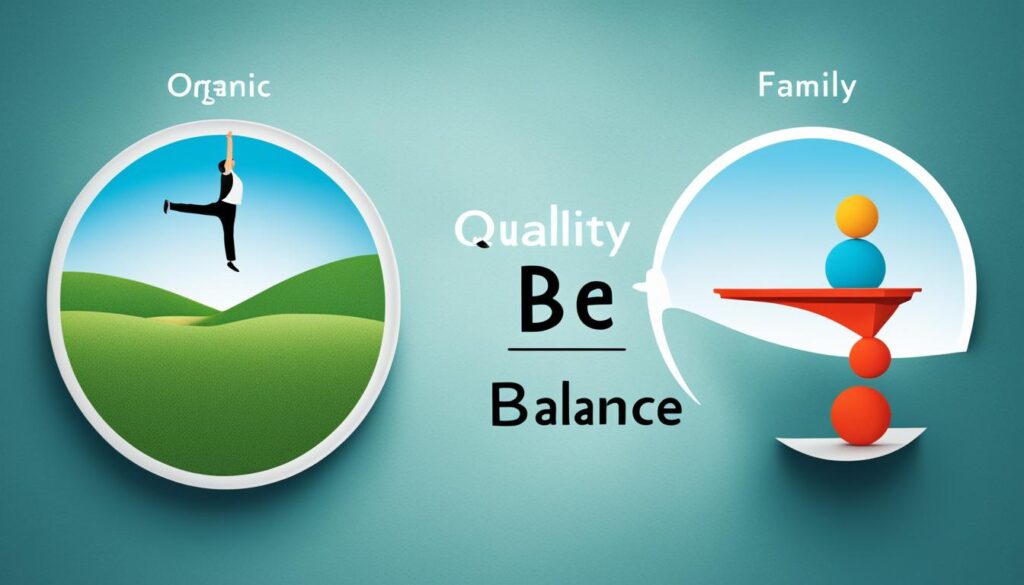Family dynamics can be both rewarding and challenging, with each family member bringing their unique personalities and experiences to the table. Navigating these dynamics can often be complex, with various emotions and behaviors at play. However, fostering harmony and encouraging growth within your family can lead to a strong support system that positively impacts all members.
In this article, we’ll explore expert strategies for navigating family dynamics to create balance and unity in your home life. By understanding common behavior patterns, improving communication, promoting emotional intelligence and individual growth, managing conflicts, and finding a balance between quality time and personal space, you can foster a healthy and supportive family environment.
Key Takeaways:
- Fostering harmony and growth in your family requires understanding and navigating family dynamics.
- Improving communication is key to promoting understanding, conflict resolution, and stronger bonds.
- Cultivating a positive family culture through shared values and traditions can create a supportive environment.
- Encouraging individual growth and autonomy while maintaining a sense of belonging is crucial to overall harmony.
- Managing conflicts effectively and finding a balance between quality time and personal space promotes family balance and well-being.
Understanding Family Behavior Patterns
Every family has unique dynamics and behavior patterns that influence its overall harmony and growth. Identifying these patterns is crucial for improving family dynamics and fostering a supportive environment. Some common family behavior patterns include:
| Behavior pattern | Impact on family dynamics |
|---|---|
| Communication style | Effective communication is key for positive family relationships. Diverse communication styles can lead to misunderstandings and conflicts if not managed properly. |
| Roles and expectations | Unspoken or unclear expectations can lead to frustration and resentment among family members. Clearly defined roles and expectations can create a sense of structure and reduce tension. |
| Conflict resolution | Disagreements are inevitable in any family, and how they are managed can have a lasting impact. Healthy conflict resolution techniques can strengthen bonds and promote growth, while unresolved conflicts can erode trust and cause long-term damage. |
| Family values and beliefs | A shared sense of values and beliefs can create a strong foundation for a positive family culture, while conflicting values can fuel tension and discord. |
By recognizing these patterns and their impact on your family dynamics, you can take steps to address them and create a more harmonious and supportive environment for every family member.

Communicating Effectively for Stronger Bonds
Effective communication is vital for creating and maintaining strong family bonds. It’s important to listen actively and communicate clearly to avoid misunderstandings and promote deeper understanding and connection.
Here are some practical strategies to improve communication within your family:
- Listen actively: Pay attention to what your family members are saying without interrupting or judging. Show empathy and understanding, even if you disagree with their opinion.
- Communicate clearly: Use simple language, avoid sarcasm or criticism, and be direct and honest when expressing your thoughts and feelings.
- Empathize: Try to put yourself in the other person’s shoes and understand their perspective. This can help to resolve conflicts and find common ground.
- Display positive body language: Smile, make eye contact, and use open gestures to show that you are engaged and interested in the conversation.
- Set aside dedicated time for communication: It’s helpful to have regular family meetings or activities that encourage open communication and bonding.
By incorporating these strategies into your family interactions, you can promote effective communication and stronger bonds with your loved ones.
«Good communication is the bridge between confusion and clarity.» — Nat Turner

Building Emotional Intelligence
Emotional intelligence is the ability to recognize and understand our own emotions and those of others, allowing us to act appropriately in social situations. This skill plays a vital role in maintaining healthy family relationships, as it fosters empathy, understanding, and mutual respect.
Fortunately, emotional intelligence can be enhanced within family members through intentional practices. Some strategies to consider include:
- Encouraging open communication: Encourage family members to share their thoughts and feelings with each other, creating a safe space for emotional expression.
- Modeling empathy: Set an example for your family by showing empathy towards others in your words and actions. Empathy involves putting yourself in someone else’s shoes to understand their perspective.
- Practicing active listening: Listening actively means focusing on the speaker and showing interest in what they are saying. Encourage family members to ask questions and summarize what was said to ensure understanding.
By building emotional intelligence within your family, you can create a more compassionate and understanding environment that supports healthy relationships and personal growth.
Example Table: Emotional Intelligence Skills
| Emotional Intelligence Skill | Description |
|---|---|
| Self-awareness | The ability to recognize and understand our own emotions and their impact on our behavior. |
| Empathy | The ability to understand and share the feelings of others, putting ourselves in their shoes. |
| Active listening | The ability to listen actively and show interest in what the speaker is saying, ensuring understanding. |
| Effective communication | The ability to express ourselves clearly and listen actively, fostering healthy relationships. |

Cultivating a Positive Family Culture
Cultivating a positive family culture is essential for creating a supportive and nurturing environment that promotes growth and well-being for every family member. By establishing shared values and traditions, your family can build deeper connections and strengthen relationships that last a lifetime.
Start by identifying the values that are most important to your family. These might include honesty, respect, kindness, or empathy. Talk to your family members about what these values mean to them and how you can all work together to embody them on a daily basis.
Another way to cultivate a positive family culture is through the establishment of traditions. These can be anything from annual family vacations to weekly game nights. Whatever traditions you choose, they should reflect your family’s values and allow everyone to connect and bond in meaningful ways.

Cultivating Positive Habits
Creating positive habits is also an essential part of cultivating a positive family culture. When everyone in the family contributes to chores, such as cooking, cleaning, and yard work, it fosters a sense of teamwork and responsibility. Encourage family members to pursue hobbies or interests they enjoy and celebrate their achievements together.
Teaching and Modeling Positive Behaviors
It’s also important to teach and model positive behaviors within the family. Children learn by example, so parents should be mindful of their own behavior and strive to set a positive example for their children. When conflicts arise, encourage family members to communicate respectfully and work together to find positive solutions.
| Benefits of a Positive Family Culture | Examples |
|---|---|
| Fosters a sense of belonging | Shared meals, family outings |
| Promotes emotional well-being | Encouragement, support, and empathy |
| Strengthens communication and conflict resolution skills | Positive communication, respectful conflict resolution |
| Improves academic and career success | Encouragement and support for learning and pursuing goals |
Creating a positive family culture takes time and effort, but it’s well worth it. By establishing shared values and traditions, cultivating positive habits, and modeling positive behaviors, you can create a supportive and nurturing environment where every family member can thrive.
Nurturing Individual Growth and Autonomy
Encouraging individual growth and autonomy within a family is crucial for overall harmony. It’s important for every family member to have a sense of self and to pursue their interests and passions. However, this can be challenging within the context of a family, where unity and belonging are also essential.
One way to support individual growth is to provide family support. This can take many forms, such as allowing each family member to pursue their interests, dreams, and goals. It’s also essential to provide support and encouragement to one another, celebrating each other’s successes and lifting each other up during setbacks.
Another way to promote individual growth is to create opportunities for autonomy. This means respecting each other’s choices and allowing family members to make decisions for themselves. For example, parents can encourage their children to make choices about their own lives, such as allowing them to pick their own extracurricular activities or hobbies. This helps to foster a sense of independence and responsibility, promoting healthy growth and development.
Strategies for Nurturing Individual Growth and Autonomy
| Strategy | Description |
|---|---|
| Encourage Open Communication | Communicate openly and respectfully with each other, promoting understanding and empathy. |
| Provide Positive Reinforcement | Offer support and encouragement for each other’s efforts and accomplishments. |
| Respect Each Other’s Boundaries | Recognize each other’s need for personal space and support each other’s decisions. |
| Celebrate Individual Achievements | Recognize and celebrate each other’s successes and milestones. |
Why Nurturing Individual Growth is Important
«When individuals within a family are supported and encouraged to pursue their interests and passions, it leads to greater overall satisfaction, happiness, and well-being. It also promotes mutual respect and understanding, which are essential for maintaining positive family dynamics.»
By nurturing individual growth and autonomy, families can create an environment that promotes unity, harmony, and well-being. When family members feel supported and encouraged to pursue their dreams and goals, it can lead to greater overall satisfaction and happiness. Moreover, it promotes a sense of respect and understanding, which helps to maintain positive family dynamics and fosters a sense of belonging.

Managing Conflict and Resolving Differences
Family conflicts are normal and bound to happen. However, it is essential to learn to manage and solve them peacefully to avoid creating lasting negative impacts on family relationships.
To avoid disruptive arguments, try to understand the root cause of the conflict, and always maintain a calm and respectful tone while communicating. Active listening is also critical in resolving differences since it ensures that everyone feels heard and understood.
One effective technique for managing conflict is compromising. Each party should state their expectations clearly and try to meet somewhere in the middle. It is better to have a win-win deal that makes everyone happy instead of one person always getting their way while others suffer in silence.
«The greatest glory in living lies not in never falling, but in rising every time we fall.» -Nelson Mandela
Learning to manage conflict is a useful life skill that can make a difference for the entire family. By practicing effective communication and conflict resolution techniques, we can reduce misunderstandings, solve issues peacefully, and promote a harmonious family environment.
Conflict Resolution Strategies:
| Strategy | Description |
|---|---|
| Compromising | Each party states their expectations and gives up something to meet in the middle. |
| Collaborating | Identify the common ground, brainstorm new options and choose a solution that benefits everyone. |
| Accommodating | One person gives up their wants to meet the other party’s needs or to maintain harmony. |
| Competing | Individuals assert their wants over others and don’t mind using power to win, even at the expense of others. |
| Avoiding | Avoiding confrontation, ignoring conflict and hoping problems will naturally fade away. |

Balancing Quality Time and Personal Space
Spending quality time with your family is essential for building stronger connections and fostering growth. However, it’s equally important to respect each member’s need for personal space. Striking a balance between the two is crucial for a harmonious family life.
Establish Family Time
Setting aside dedicated family time helps ensure that everyone has the opportunity to bond and connect. Consider scheduling regular family activities, such as game nights or outdoor excursions. Make sure that these activities are enjoyable for everyone, and ask each family member to contribute ideas.
Encourage Alone Time
While spending time together is important, it’s also necessary to provide opportunities for alone time. Encourage each family member to pursue solo activities that interest them, like reading, practicing a hobby, or simply relaxing. Make sure everyone respects each other’s personal time and avoids interrupting unless it’s urgent.

«The largest part of what we call ‘personality’ is determined by how we’ve opted to defend ourselves against anxiety and sadness.»
― Alain de Botton
Be Flexible
Finding the balance between quality time and personal space is not an exact science. It requires flexibility, communication, and a willingness to adapt. Keep an open mind and be willing to adjust your expectations and plans when necessary.
Model Healthy Behavior
Lead by example and prioritize your own personal time. This demonstrates the importance of self-care and healthy boundaries to your family. It also sets a positive standard for how family members should treat each other’s personal time and boundaries.
With these strategies, you can create a harmonious balance that meets everyone’s needs. Remember that a balance between quality time and personal space is unique for each family and may require trial and error to find the perfect mix.
Conclusion
Family dynamics can be complex and challenging to navigate, but by implementing the strategies outlined in this article, you can foster harmony and growth within your family. Remember to communicate effectively, cultivate a positive family culture, and support individual growth and autonomy. By managing conflicts and finding a harmonious balance between quality time and personal space, you can create a fulfilling and supportive environment for your family.
Embracing these expert strategies will not only benefit your family dynamic but also promote personal growth and well-being for each family member. Start implementing these techniques today to create a happier and more united family tomorrow.
FAQ
What are family dynamics?
Family dynamics refer to the patterns, interactions, and relationships within a family. It involves understanding how family members communicate, behave, and influence one another.
How can I improve family dynamics?
Improving family dynamics involves effective communication, active listening, understanding and respecting each other’s perspectives, resolving conflicts, and fostering a supportive and nurturing environment.
Are family behavior patterns important?
Yes, family behavior patterns are crucial as they provide insights into how family members interact and affect each other. Understanding these patterns helps in identifying areas that require improvement for better family dynamics.
What role does effective communication play in strengthening family bonds?
Effective communication is essential in building stronger family bonds. It involves active listening, expressing emotions and needs, and resolving conflicts respectfully. Good communication promotes understanding, empathy, and healthy relationships within the family.
How can I enhance emotional intelligence within my family?
To enhance emotional intelligence within your family, encourage open discussions about emotions, practice empathy and understanding, teach emotional regulation strategies, and promote active listening and acceptance of diverse emotions.
How can I cultivate a positive family culture?
Cultivating a positive family culture involves establishing shared values and traditions, promoting appreciation and respect, fostering open communication, encouraging support and growth, and creating a safe and nurturing environment for all family members.
How can I support individual growth and autonomy while maintaining family harmony?
Supporting individual growth and autonomy within a family requires encouraging self-expression, providing opportunities for personal development, respecting each other’s choices and boundaries, and maintaining open lines of communication and support.
What are effective techniques for managing conflict within a family?
Effective conflict management involves active listening, seeking compromise, practicing empathy and understanding, finding common ground, and fostering open communication to address and resolve differences in a respectful and constructive manner.
How can I balance quality family time and personal space?
Balancing quality family time and personal space requires setting boundaries, scheduling dedicated family time, respecting each other’s need for alone time, and finding a harmonious balance that meets the needs of every family member.
